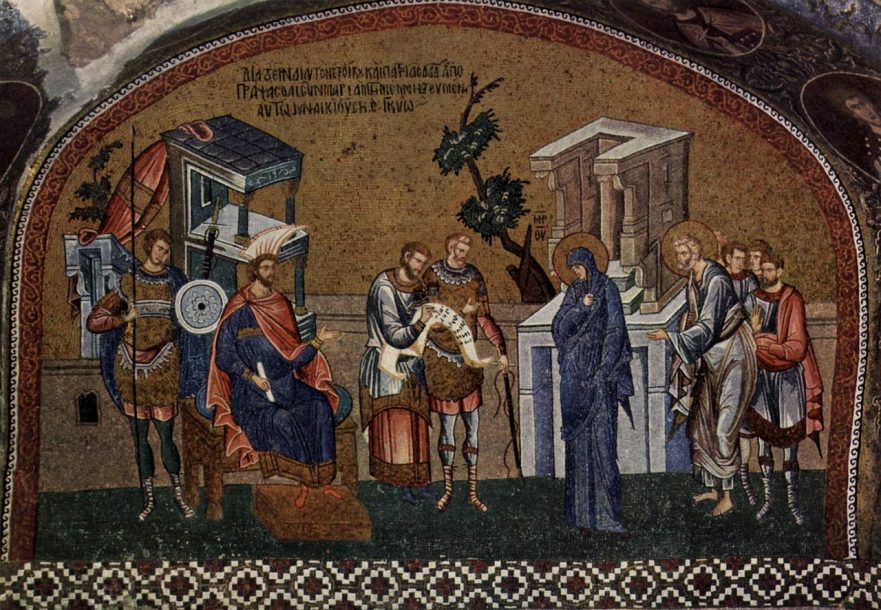Think of the year 1776 and the day of September 11, 2001. Most Americans identify these dates with specific events in our history. For Americans, 1776 is the year the American Revolution began and the thirteen colonies sought to gain their freedom from England. September 11, 2001, of course, recalls the terrible and tragic events of the terrorist attacks on the World Trade Center, the Pentagon, and a field near Shanksville, Pennsylvania. Although other events occurred in the world in 1776 and on September 11, 2001, the collective American conscience ties these dates to defining moments in our history.
In his Gospel, Luke offers a similar defining date that was part of the collective Jewish conscience of the first century:
And it happened in those days, a decree went out from Caesar Augustus that all the world should be registered. This census took place for the first time when Quirinius was governor of Syria. (Luke 2:1-2; emphasis added)
Modern readers tend to overlook the significance of the date of Quirinius’ census. Preachers and interpreters frequently point to Luke’s mention of the census as proof that God maneuvered even the pagan Roman authorities to bring about Jesus’ birth in Bethlehem. Few note the significance of the date within the history of the Jewish people living in the land of Israel. It’s my feeling that the events surrounding the census of Quirinius drew Luke to mention it within his narrative and connect Jesus’ birth to this event. He intended his mention of the census to illicit a connection in the minds of his readers between the birth of Jesus, the Messiah, and the events that happened in the land of Israel as a result of the census. The historical and political outcome of the census provides the backdrop that Luke expected his first-century readers to relate to the birth of Jesus, the Messiah.
Premium Members and Friends of JP must be signed in to view this content.
If you are not a Premium Member or Friend, please consider registering. Prices start at $5/month if paid annually, with other options for monthly and quarterly and more: Sign Up For Premium

This article is just one chapter of Marc Turnage’s, Windows into the Bible: Cultural and Historical Insights into the Bible for Modern Readers (Springfield, Mo.: Logion, 2016). If you enjoyed this chapter, be sure to check out the entire book!
- [1] In the Lower Golan, on the Transjordan (eastern) side of the Sea of Galilee. In the parallel passage from Josephus’ War, Josephus identifies him as “a Galilean” (2.117). Although Judas was from Gamla (in the north), his uprising as a result of the census took place in the south, in the former territory of Archelaus (i.e., in the environs of Jerusalem). ↩
- [2] Menahem Stern, “Zealots and Sicarii,” in Encyclopedia Judaica (2nd ed.; 22 vols.; New York:
Macmillian Reference, 2006), 21:467-78; Flusser, “The Image of the Masada Martyrs in Their Own Eyes and in the Eyes of Their Contemporaries,” in Judaism of the Second Temple Period: The Jewish Sages and Their Literature (Grand Rapids: Eerdmans, 2009), 76-112. ↩ - [3] Stern, “Zealots and Sicarii,” 468. ↩
- [4] Judah’s father, Hezekiah, also resisted Roman intrusion into the land of Judea in the 40s BC (War 1.204-5; Ant. 14.159-60). Based in Galilee, he stirred up trouble in the countryside for the Romans, which led to his execution by the young Herod the Great, who had been appointed governor of Galilee. Hezekiah’s execution generated unrest in Judea and resulted in Herod having to stand before the Sanhedrin in Jerusalem. ↩
- [5] See Martin Hengel, The Zealots: Investigations into the Jewish Freedom Movement in the Period from Herod I until 70 AD (trans. David Smith; Edinburgh: T&T Clark, 1989), 79. ↩




Comments 3
Hello,
How do you explain that there is historical discrepancy regarding the date of Quirinius’ being governor over Syria, and the birth of Jesus? How do you interpret that?
Hi evanhierden,
We’ve forwarded your question to Marc Turnage, so hopefully we’ll hear back from him soon. In the meantime, we can recommend the Menahem Stern’s discussion of the problems relating to the date of Quirinius’ tenure as governor and the birth of Jesus, which is found in The Jewish People in the First Century (ed. S. Safrai and M. Stern; Philadelphia: Fortress, 1974), 1:372-374.
Very interesting perspective. Great insight into the Gospel of Luke!